- info@wildlifeanimalcontrol.com
Call us for help in your town
Wildlife Control Education
How to Get Rid of Coyotes
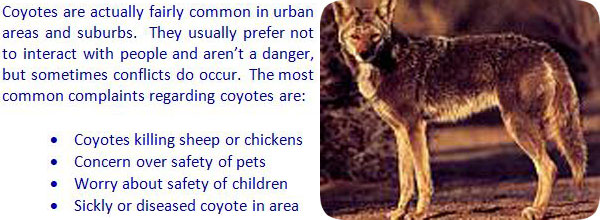
It is my goal to educate the public about coyotes and other wildlife, and
provide tips for safe, effective, and responsible wildlife removal.
Need coyote removal in your hometown? We service over 500 USA locations! Click here to hire us in your town and check prices - updated for year 2020.
How to Get Rid of Coyotes - Coyotes have only recently become a pest because the coyote population continues to explode while their territory is getting smaller and smaller. What does this mean for the interaction between coyotes and humans? As the coyote's habitat gets smaller and their population grows, they have to live by humans to get food and shelter. The coyote is the size of a medium sized dog, but much smaller than a wolf. Their coats can range in colors, but the usual coat color is a tan, gray white mixture. You can tell a coyote from a dog because they are very skittish of humans and they are much skinnier than the average dog. The howl of a coyote is unmistakable and very annoying as it sounds like a baby crying or a dying animal.
Coyotes are not usually considered pests, but now that they are encroaching upon our backyards there are some behaviors that are not conducive to that arrangement. Coyotes play an important part in keeping the rodent population controlled, but they will also snack on your family pet if given the opportunity. Coyotes will also break into your garbage cans and make a huge mess. For light sleepers, coyotes can be a really big problem because they are mainly active at night and their howls are very loud. When coyotes get together, or if it is mating season, the howls are particularly irritating. If you have coyotes lurking around your backyard, you probably want to get rid of them as soon as possible. Try some of these suggestions and you will be coyote free in no time.
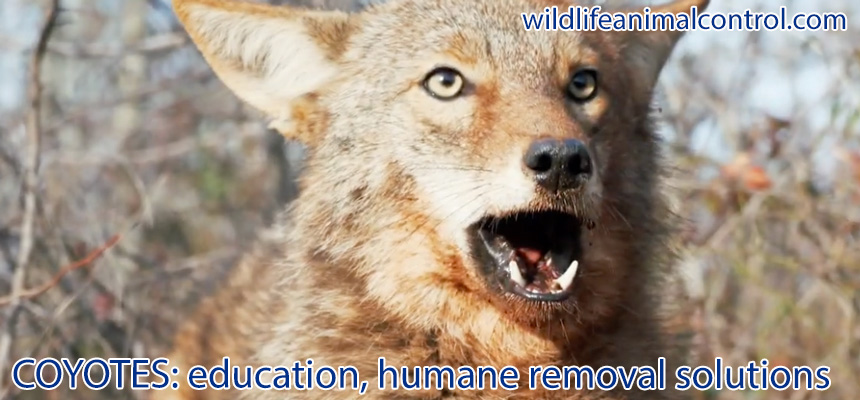
- The best way to get rid of coyotes without harming them is to take away their food sources. You can do this several ways. Stop feeding your dogs and cats outside and keep their food inside all the time so the coyote cannot steal the food off of your porch at night. The next thing you must do is to secure your trash cans in your garage or in a special shed that is made just for your garbage cans. Also, keep fallen fruit off the ground and build a fence around your garden.
Here are more ideas on how to keep coyotes away - prevention techniques.
- The other way that you can take away a coyote's food source is to significantly reduce your rodent population. The best way to do this is to keep the property clean, and free of food sources, like garbage or grains. You can set outdoor trapping stations, but that won't significantly reduce rat numbers. I don't recommend poisoning rats or any animal. Cats can also lower the rat and mouse population on your property, but you may want to rethink having outdoor cats if you have coyotes around, because cats are a coyote's favorite snack.
- Try to keep your yard very maintained, like making sure your grass is cut short and your bushes and trees are trimmed. This takes away the coyote's opportunities for shelter. If they have nowhere that they feel safe enough to sleep in during the day, they will not stick around, especially if they have no food.
- The last trick that you can try is to trap the coyotes. This is extremely difficult to do because coyotes are very cautious. If you do want to trap them, make sure that you are wearing latex gloves and wash the trap with soap beforehand to cover your scent. Place the trap over a hole with meat in it to get the coyote to come into the trap. If you trap the coyote, you are told to euthanize the animal instead of relocating it. If this is not your cup of tea then you should try the other indirect methods or call a professional to remove the animal.
Here is in-depth information about coyote trapping - analysis and methods for how to trap.
More in-detail how-to coyote removal articles:
Information about how to kill a coyote - with poison or other methods.
Information about how to catch a coyote - remove one stuck in the house.
Information about coyote repellent - analysis of types and effectiveness.
Coyote Information & Facts
Coyote Appearance: Coyotes are members of the dog family, usually light tan in color with a spattering of darker browns and black markings throughout. They range in height from two to three feet and are approximately four feet in length. A healthy coyote will weigh anywhere between twenty and forty pounds, with females on the lighter end of the spectrum. A pack of coyotes is less common than hunting pairs, but the solidarity of the animals will depend on the game present in the area.Coyote Habitat and Behavior: Coyotes are very adaptive, living in most states and most environments. These dog-like predators vary in characteristics based on the region they live in. Rural coyotes will be reclusive in nature, favoring high hills and open expanses, and always travelling on established trails. Though able to dig their own burrows, coyotes will often steal the homes of foxes, woodchucks, or badgers. Urban coyotes living in close quarters with humans have adapted to a more scavenger lifestyle and will invade yards or porches to feed on house pets. Wolves will keep a coyote population in check, and in states where wolves are not present the coyote community has thrived. Wolves are the natural enemies of coyotes, and both species will kill and eat the other's offspring. Despite this rivalry, coyotes and wolves have been known to interbreed, creating a sub-species known as the coywolf. Coyotes breed only once a year, giving birth to litters of up to nineteen young. Mated pairs will remain together for an indefinite number of years, though they are not mated for life as previously thought.
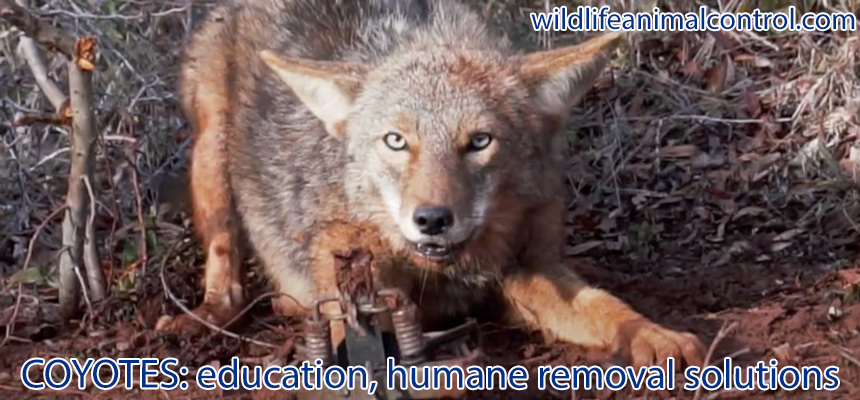
Coyote Diet and Hunting: Mostly carnivorous, coyotes generally live off a diet consisting of small mammals. Mice, rabbits, groundhogs and the like make up the nutritional fare for a rural coyote, though the creatures will group together and take down larger game if smaller food is scarce. Urban coyotes will scavenge carcasses, garbage, and kill a large number of cats and small dogs as well as rats. Though meat is the most common diet, fruit and vegetation play a significant role in coyote nutrition. Hunting techniques are an area where the ingenuity of the coyote is apparent. In snow-covered conditions, the coyote's excellent sense of hearing can detect the movement of creatures beneath the cold ground cover. A coyote hunting a small animal in this manner will stalk the prey before selecting a moment to initiate a quick, pointed attack. Pack hunting can range from ambushing an animal to setting up traps with hidden pack members. A pack will also run a prey animal to exhaustion, often taking turns among members to run the animal down.
Coyote Nuisance Issues: Coyotes are often classified as nuisance animals. This classification occurs when livestock - especially sheep, goats, and chickens is looked on as prey. Once a coyote determines an easy, reliable source of food is at hand, it will often return to the area and continue picking off members of the herd. This chronic visitation can be detrimental to a farmer's business if left unchecked. People closer to cities and suburbs also have issues with coyotes, though the loss of livestock is not a primary concern. Coyotes in populated areas are bold and will often leap fences to hunt a cat or dog. In some cases, children or lone runners may be targeted if too close to pack territory. This close proximity creates a concern for the possibility of the spread of zoonotic disease.
Coyote Diseases: The number of illnesses communicable from coyotes to people is few but tends to be serious in nature. Rabies is a deadly disease, characterized by neurologic symptoms, and is always fatal. Less lethal illnesses include leptospirosis, a bacterial infection, and secondary infections from parasites such as Lyme disease or ehrlichiosis. Significant threats exist for domesticated dogs. Coyotes can harbor Canine Distemper Virus, a potentially lethal infection for young and unvaccinated pets. Domestic pets are also susceptible to rabies and leptospirosis.
You're here to learn about how to get rid of coyotes in your yard. This site is intended to provide coyote education and information, so that you can make an informed decision if you need to deal with a coyote problem. This site provides many coyote control articles and strategies, if you wish to attempt to solve the problem yourself. If you are unable to do so, which is likely with many cases of coyote removal, please go to the home page and click the USA map, where I have wildlife removal experts listed in over 500 cites and towns, who can properly help you with your nuisance coyote.
Urban Coyote
By Philip J. NicholsI grew up in southeastern Pennsylvania in the 1950's. There were no coyotes there back then. In the years since, coyotes have expanded their range to include cities everywhere in North America. The average person did not notice, their numbers were not great yet, and they had changed their normal activities to become nocturnal and less vocal. For a while, they would be in stealth mode, until the new habitat was mastered.
Well they have figured out how to live in the city where the humans did not chase them with dogs, shoot at them, or catch them in traps. To be fair, there are no chicken coops or livestock pastures, but plenty of other tasty things to eat. No longer did coyotes worry about man or the other hazards of living in farm land and wilderness - he was safe from traditional large predators, the lion, bear, wolf and man. But in the city, he must learn how to negotiate traffic so as not to become roadkill.
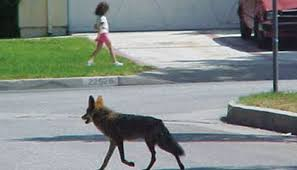
Not all habits were modified. The range of radio collared city coyotes was similar to their country cousins - between two and ten square miles. The majority of their diet still was made up of small rodents, birds fawns and vegetable/fruit. A new feature in their diet is the Canada goose, and goose eggs. These large tasty birds have greatly populated the urban expanse along with whitetail deer. Coyotes do get into trouble killing small pets, and chasing children. Their "chase" instinct is triggered when something runs away from them. These incidents are common everywhere, and have been showing up on the evening news since the 1980's.
The typical complaint to authorities are coyote sightings, aggression and attacks on pets. City folk are afraid to use their yards, let their children play, and walk pets. The problem is that the police and local governments have no plan to deal with these complaints. That is changing, especially in southern California where coyote problems are more numerous than anywhere else in the US. When a three year old lost her life in Glendale, bounty hunters were hired and over fifty coyotes were exterminated.
In many places, local governments refer residents to nuisance wildlife control operators (NWCO's,) who charge money to take care of wildlife problems. The solution depends on many factors and may include trapping where legal. In many areas coyotes are on the rabies vector species list and the trapper is legally bound to euthanize trapped coyotes according to protocol. Coyote traps come in many forms, and are effective when the trapper using them has the necessary skills and knowledge. Foothold traps are the overwhelming choice by coyote trappers. "Wiley" is the coyote's nickname for good reason, and a sloppy or ignorant trapper will do nothing more than educate the local pack, making trapping all the more difficult. And to be sure, there is a pack, although they do not always travel or hunt in groups. A typical trapping strategy uses multiple foothold traps in a "gang" setting, to catch multiple animals at a one location. The next most used device is the snare or "cable restraint." These can be set up to capture the animal alive, or kill it. Snares used properly in populated areas allow for a roaming dog to be released unharmed. A variant of the snare, is a canine specific device called Collarum. This is a spring loaded mechanism that throws a non-choking loop over the canine's head which secures the animal; the tether holds them in place. A captured dog reacts as if it is on a leash.
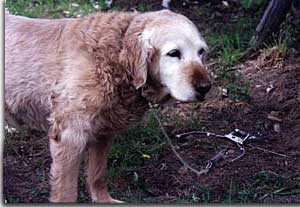
Some trappers attempt to catch coyotes in cage traps. This is a relatively new approach, and the methods are still being developed. The trap must be overly large, and there is an option for a separate compartment to hold live bait. Results indicate city coyotes enter cage traps more than country coyotes. Pups and yearlings are also easier to catch. But if trapping or hunting is not an option, what can be done?
Academic studies have been done in Winnipeg, Calgary, Los Angeles, New York City (the first coyote report in 1995 was a road kill on the Bronx Expressway,) Chicago, Minneapolis, Culver City and Richmond. The results help us understand coyote behavior in urban areas. These studies examined DNA, scat (poop,) and stomach contents. Some three hundred road killed coyotes were necropsied at the University of California, Irvine. Some studies rely on reported information from a crowdsourced application called "coyote catcher." All of this data defines a mid size predator/omnivore that is firmly established in most urban/suburban locations.
The diet preferences of these city dwellers is based on local availability of rodents, domestic cats and small dogs, exotic fruits and berries planted by trendy homeowners and deer fawns. Garbage generated by people was around one percent. Neighborhood coyotes are there because food and shelter needs are provided. If these are on your or your neighbors property, try to remove them . Clean up dropped fruit, secure trash, eliminate mice, rats and other rodents, and fence gardens, berry bushes and fruit trees. A coyote that seems comfortable sitting in the yard can be hazed with loud noises to be made uncomfortable. A rogue coyote that attacks humans and pets needs to be removed, and I would do that any way possible, as soon as possible. If there is some ordinance, law or government prohibition, practice SSS (shoot, shovel, shut up.)
Read more About Coyotes in my educational articles. Find out if coyotoes are dangerous to humans or are dangerous to pets.

















